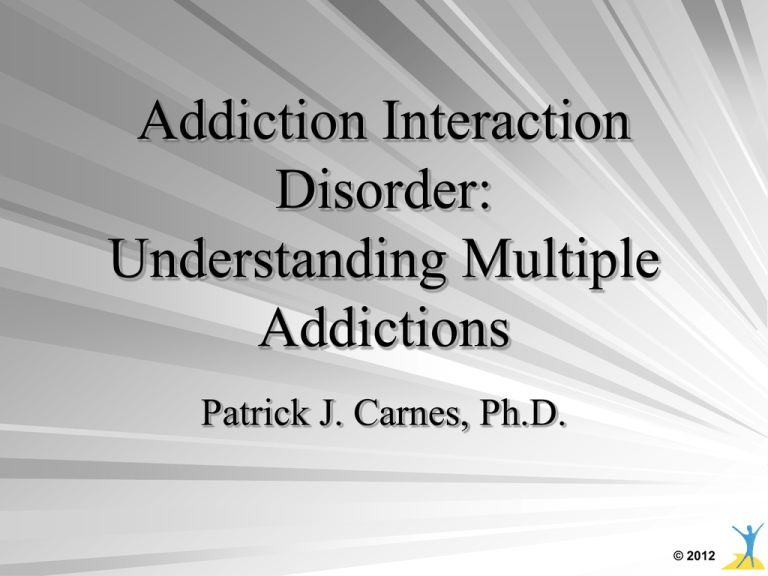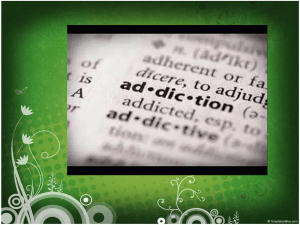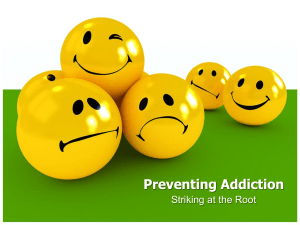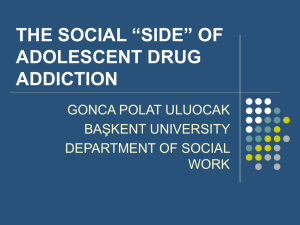
Addiction Interaction
Disorder:
Understanding Multiple
Addictions
Patrick J. Carnes, Ph.D.
© 2012
Gambling (N=103)
100%
83%
48%
50%
31%
0%
Sexual Addiction
Sexual Anorexia
Both
© 2012
Alcoholism (N=740)
100%
80%
52%
50%
33%
0%
Sexual Addiction
Sexual Anorexia
Both
© 2012
Substance Abuse (N=664)
100%
82%
49%
50%
33%
0%
Sexual Addiction
Sexual Anorexia
Both
© 2012
Eating Disorder (N=213)
100%
65%
66%
50%
33%
0%
Sexual Addiction
Sexual Anorexia
Both
© 2012
Addiction Interaction
Gambling
Eating Disorder
100%
100%
50%
50%
0%
0%
Sexual Addiction
Sexual Anorexia
Both
Sexual Addiction
Alcoholism
100%
50%
50%
0%
0%
Sexual Anorexia
Both
Substance Abuse
100%
Sexual Addiction
Sexual Anorexia
Both
Sexual Addiction
Sexual Anorexia
Both
© 2012
Challenges to Recovery
Addiction is a brain disease
© 2012
Addiction is a brain disease
expressed in the form of
compulsive behavior.
Alan I. Leshner, MD
Former director of the National
Institute on Drug Abuse
© 2012
Neurochemistry
Nucleus Accumbens—Brain’s Reward Center
Normal
Obese
Red
indicates
high
number of
receptors
for
dopamine
People short
of dopamine
have
difficulty
feeling joy.
Alcoholic
Cocaine
Hans Breiter, director of the Motivation and Emotion Neuroscience Center at
Massachusetts General Hospital
© 2012
Natural Rewards Elevate Dopamine Levels
200
% of Basal DA Output
NAc shell
150
100
Empty
50
Box Feeding
SEX
200
150
100
15
10
5
0
0
0
60
120
Time (min)
180
ScrScr
BasFemale 1 Present
Sample 1 2 3 4 5 6 7 8
Number
Scr
Copulation Frequency
DA Concentration (% Baseline)
FOOD
Scr
Female 2 Present
9 10 11 12 13 14 15 16 17
Mounts
Intromissions
Ejaculations
Source: Di Chiara et al.
Source: Fiorino and Phillips
©2008 Patrick J.©Carnes,
2012 PhD
Accumbens
1100
1000
900
800
700
600
500
400
300
200
100
0
AMPHETAMINE
DA
DOPAC
HVA
250
NICOTINE
200
Accumbens
Caudate
150
100
Accumbens
COCAINE
DA
DOPAC
HVA
300
200
100
0
5 hr
250
% of Basal Release
1
2
3
4
Time After Amphetamine
% of Basal Release
400
0
% of Basal Release
% of Basal Release
Effects of Drugs on Dopamine Levels
0
1
2
3
4
Time After Cocaine
Accumbens
5 hr
ETHANOL
Dose (g/kg ip)
200
0.25
0.5
1
2.5
150
100
0
0
1
2
3 hr
0
Time After Nicotine
Source: Di Chiara and Imperato
0
1
2
3
Time After Ethanol
4hr
© 2012
Common Language of
Technological Change
Internet sex as the “crack cocaine” of sexual
compulsivity
– Al Cooper Ph.D.
Machine video poker as the “crack cocaine” of
compulsive gambling
– Robert Hunter, Ph.D.
© 2012
Definition of a Black Hole:
A celestial phenomenon when a
massive star collapses from its
own gravity. A black hole has
such a strong pull that not even
light can escape from it.
© 2012
Addiction Interaction
An addiction phenomenon where
multiple addictions combine to
overwhelm a person by their
complexity and power.
Phenomenon is so strong, no
specific focus is strong enough to
escape from it.
© 2012
Challenges to Recovery
Addiction is a brain disease
• Addiction can be the gateway to the
pursuit of excellence
© 2012
Challenges to Recovery
Addiction is a brain disease
• Addiction can be the gateway to the pursuit of
excellence
• Addiction often has a trauma component
© 2012
ABUSE AND ADDICTION
265 Indicated Some Abuse (92.3%)
(N=264)
Sexual
Physical
Emotional
No
11
Yes
31
No
26
Yes
16
No
7
Yes
35
2 – 3 Addictions 35
60
51
44
10
85
110
____
201
36
____
113
91
____
151
4
____
21
123
____
243
One Addiction
4+ Addictions
17
____
63
23.9% 76.1% 42.8% 57.2% 8.0% 92.0%
© 2012
© 2012
National Violence Against
Women Survey
Persons raped or physically assaulted in
lifetime by sex of victim
Women -- 55% or 55,383,350
Men -- 67% or 61,955,644
Last twelve months:
Women -- (302,091) 1,913,243
Men -- (92,748) 3,153,432
© 2012
NAVW Survey
Seventy-six per cent of the women who were
raped and/or physically assaulted since the age
of 18 were assaulted by a current or former
husband, cohabiting partner, or date.
Another twenty six per cent knew their
assailant.
Only fourteen per cent were victimized by a
stranger.
© 2012
Compulsive Attachment:
Key Characteristics
Troubled people
Hero and pathological giving
High Intensity and Drama
Boundary Collapse
Impression Management
Conflict Avoidance
© 2012
“The addictive dependence on
feelings of pain…”
Alice Miller, The Drama of the
Gifted Child
© 2012
•
•
•
•
•
•
despair
intensity/risk
self-loathing
shame
misery
rage
Addiction Interaction
Disorder
Addictions more than coexist,
they interact, reinforce, become
part of one another. They become
packages.
© 2012
© 2012
Cross Tolerance
A. Simultaneous increase in addictive behavior
in two or more addictions.
B. Transfer of a high level of addictive activity
with little or no developmental sequence.
© 2012
Withdrawal Mediation
One addiction serves to
moderate, relieve, or avoid
withdrawal from another.
© 2012
Replacement
One addiction replaces another
with majority of emotional and
behavioral features.
© 2012
Alternating Addiction
Cycles
Addictions cycle back and forth
in a patterned systemic way.
© 2012
Masking
Addict uses one addiction to
cover up for another, perhaps
more substantive addiction.
© 2012
Ritualizing
Addictive behavior of one
addiction serves as a ritual
pattern to engage another.
© 2012
Intensification
Fusion dependence: neither
addiction separately is sufficient;
only simultaneous use is
sufficient.
© 2012
Intensification
Partial Fusion: Addict combines
addictions in such a fashion to be
more potent than each addiction
separately; addictions are used
independently part of the time.
© 2012
Intensification
Binge Features: episodic multiple
use, yet functionally independent
of one another.
© 2012
© 2012
© 2012
Numbing
Addiction is used to medicate
shame or pain caused by other
addiction or addictive bingeing.
© 2012
Disinhibiting
One addiction is used to lower
inhibitions for other addictive
acting out.
© 2012
Combining
Mixing addictive experiences to
moderate responses due to
neuropathway interaction.
© 2012
Addiction Interaction: Patient
Recognition (N=650)
Cross Tolerance – 59%
Withdrawal Mediation – 59%
Numbing – 59%
Fusion –57%
Masking – 56%
© 2012
Addiction Interaction: Patient
Recognition (N=650)
Replacement – 47%
Disinhibiting – 46%
Ritualizing – 44%
Combining – 38%
Alternating Addiction Cycles –36%
© 2012
Addiction Interaction Paradigm
Changes:
Diagnostic Framework: revision of DSM
Treatment Process: depth and scope
Treatment Focus: the underlying issues
Relapse Prevention: addictions as packages
Altered Strategies: first step, screen,
neuropathways
Mirror Patient Realities: professional
allegiances
© 2012
Challenges to Recovery
Addiction is a brain disease
• Addiction can be the gateway to the pursuit of
excellence
• Addiction often has a trauma component
• Addiction can take many forms
• Addiction treatment is difficult to access
for many
© 2012
Challenges to Recovery
•
•
•
•
Addiction is a brain disease
Addiction can be the gateway to the pursuit of
excellence
Addiction often has a trauma component
Addiction can take many forms
Addiction treatment is difficult to access for many
• Addiction and recovery interfere with
advocacy
© 2012
Additional Information
© 2012
For more on the Certified Sex Addiction Therapist (CSAT)
trainings, the task-centered approach to addiction recovery,
and assessment testing for sexual, work and financial
issues go to:
www.IITAP.com
or email
Info@IITAP.com
or call
(480) 575-6853
© 2012
Gentle Path Press
For books, workbooks, CDs & DVDs
on the subject of sex addiction and recovery,
please visit:
www.GentlePath.com
or call
(800)708-1796
© 2012
SexHelp
For additional information about
Dr. Patrick Carnes, links to other resources,
current topics in research, and popular literature,
go to:
www.SexHelp.com
© 2012








